fuel additives VOLKSWAGEN TRANSPORTER 2021 Owners Manual
[x] Cancel search | Manufacturer: VOLKSWAGEN, Model Year: 2021, Model line: TRANSPORTER, Model: VOLKSWAGEN TRANSPORTER 2021Pages: 486, PDF Size: 69.28 MB
Page 344 of 486
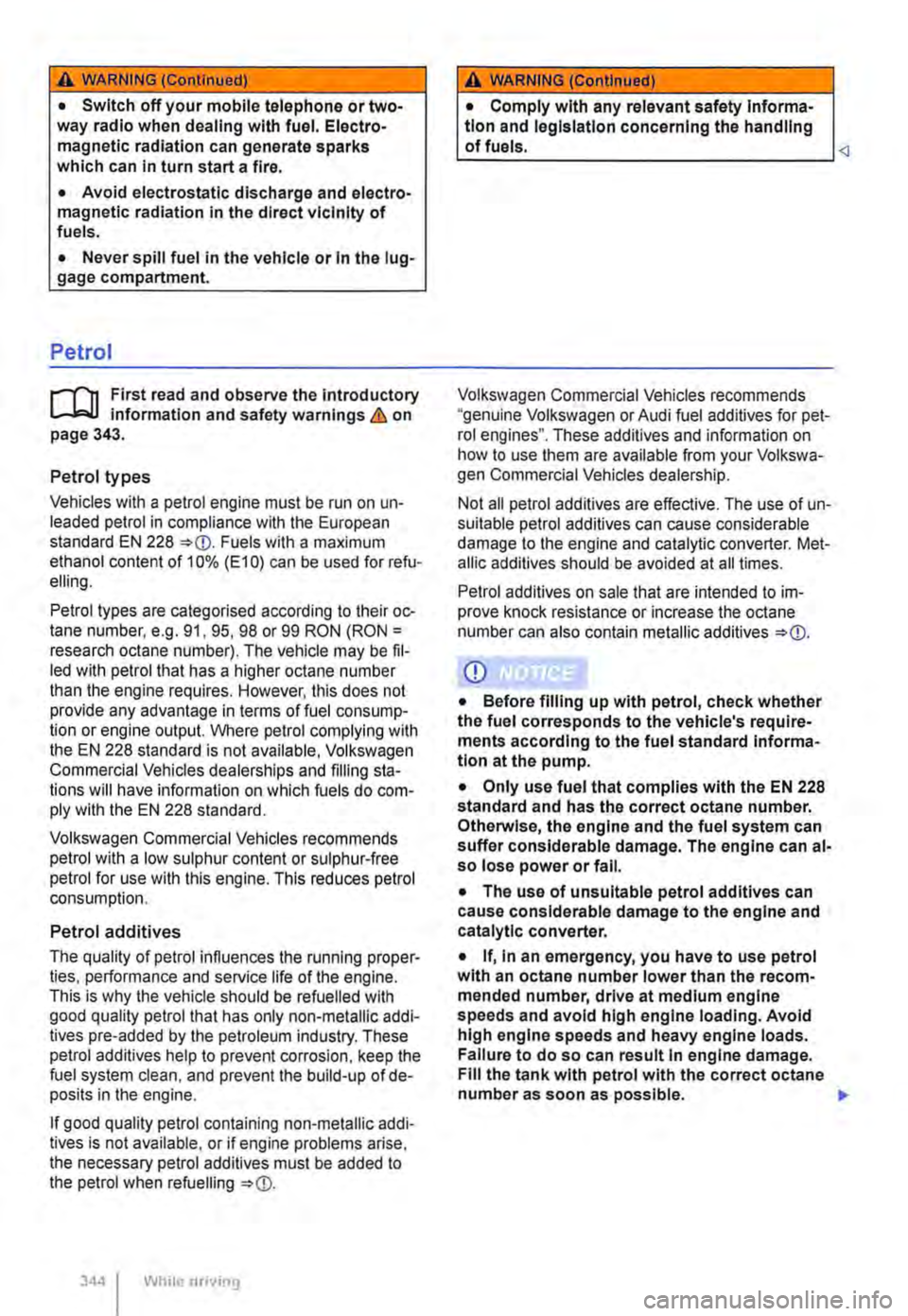
A WARNING (Continued)
• Switch off your mobile telephone or two-way radio when dealing with fuel. Electro-magnetic radiation can generate sparks which can in turn start a fire.
• Avoid electrostatic discharge and electro-magnetic radiation in the direct vicinity of fuels.
• Never spill fuel in the vehicle or In the lug-gage compartment.
Petrol
1"'111 First read and observe the introductory L-lo::.l.l information and safety warnings & on page 343.
Petrol types
Vehicles with a petrol engine must be run on un-leaded petrol in compliance with the European standard EN 228 =>
Volkswagen Commercial Vehicles recommends petrol with a low sulphur content or sulphur-free petrol for use with this engine. This reduces petrol consumption.
Petrol additives
The quality of petrol influences the running proper-ties, performance and service life of the engine. This is why the vehicle should be refuelled with good quality petrol that has only non-metallic addi-tives pre-added by the petroleum industry. These petrol additives help to prevent corrosion. keep the fuel system clean, and prevent the build-up of de-posits in the engine.
If good quality petrol containing non-metallic addi-tives is not available, or if engine problems arise. the necessary petrol additives must be added to the petrol when refuelling =>
A WARNING (Continued)
• Comply with any relevant safety Informa-tion and legislation concerning the handling of fuels.
Not all petrol additives are effective. The use of un-suitable petrol additives can cause considerable damage to the engine and catalytic converter. Met-allic additives should be avoided at all times.
Petrol additives on sale that are intended to im-prove knock resistance or increase the octane number can also contain metallic additives =>
• Before filling up with petrol, check whether the fuel corresponds to the vehicle's require-ments according to the fuel standard Informa-tion at the pump.
• Only use fuel that complies with the EN 228 standard and has the correct octane number. Otherwise, the engine and the fuel system can suffer considerable damage. The engine can al-so lose power or fall.
• The use of unsuitable petrol additives can cause considerable damage to the engine and catalytic converter.
• If, In an emergency, you have to use petrol with an octane number lower than the recom-mended number, drive at medium engine speeds and avoid high engine loading. Avoid high engine speeds and heavy engine loads. Failure to do so can result In engine damage. Fill the tank with petrol with the correct octane number as soon as possible. .,.
Page 345 of 486
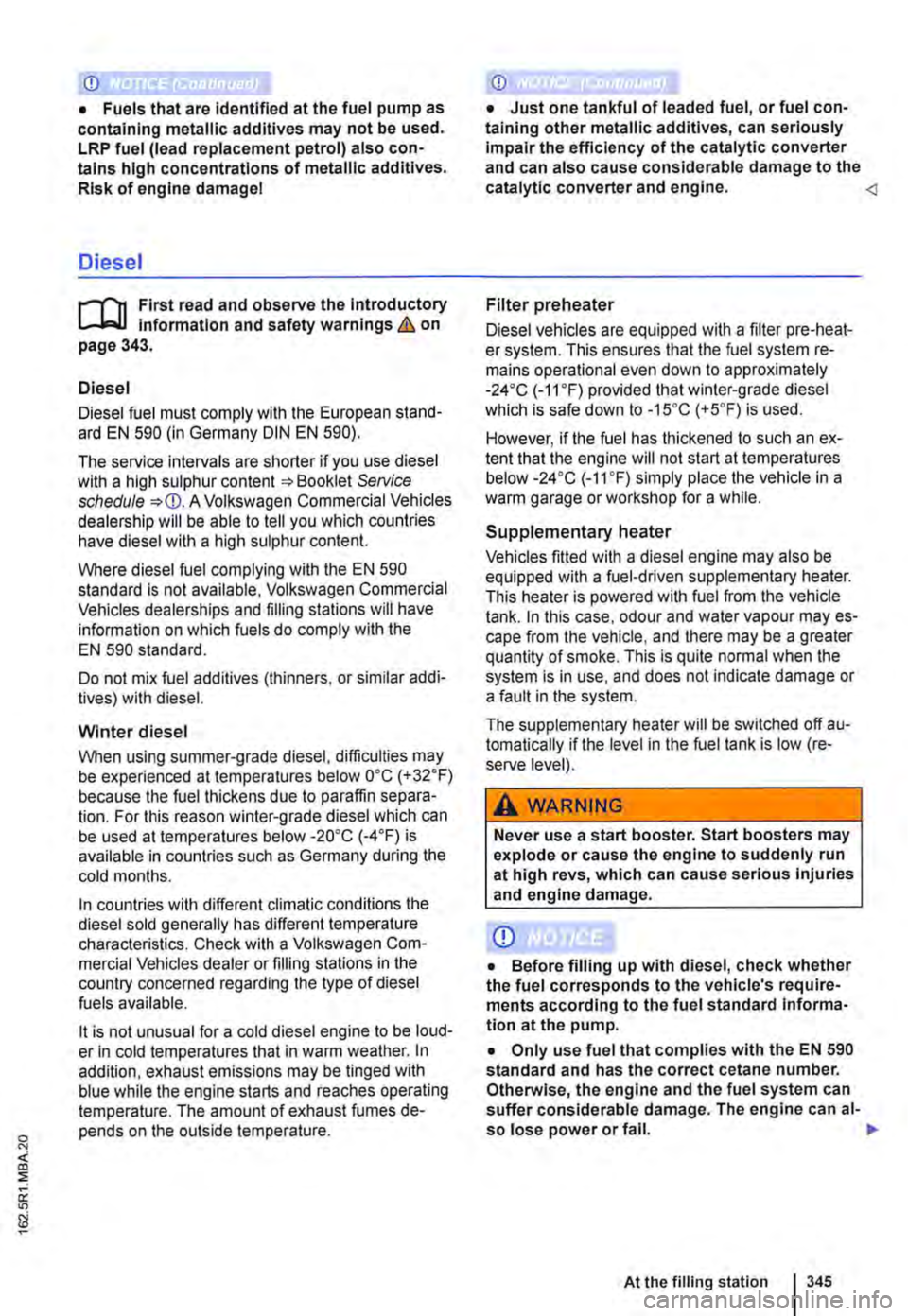
CD
• Fuels that are identified at the fuel pump as containing metallic additives may not be used. LRP fuel (lead replacement petrol) also con-tains high concentrations of metallic additives. Risk of engine damage I
Diesel
r'""'('n First read and observe the Introductory L-J,:.U Information and safety warnings & on page 343.
Diesel
Diesel fuel must comply with the European stand-ard EN 590 (in Germany DIN EN 590).
The service intervals are shorter if you use diesel with a high sulphur content =>Booklet Service schedule =>CD. A Volkswagen Commercial Vehicles dealership will be able to tell you which countries have diesel with a high sulphur content.
Where diesel fuel complying with the EN 590 standard is not available, Volkswagen Commercial Vehicles dealerships and filling stations will have information on which fuels do comply with the EN 590 standard.
Do not mix fuel additives (thinners. or similar addi-tives) with diesel.
Winter diesel
When using summer-grade diesel. difficulties may be experienced at temperatures below o•c (+32.F)
because the fuel thickens due to paraffin separa-tion. For this reason winter-grade diesel which can be used at temperatures below -2o•c (·4°F) is available in countries such as Germany during the cold months.
In countries with different climatic conditions the diesel sold generally has different temperature characteristics. Check with a Volkswagen Com-mercial Vehicles dealer or filling stations in the country concerned regarding the type of diesel fuels available.
it is not unusual for a cold diesel engine to be loud-er in cold temperatures that in warm weather. In addition, exhaust emissions may be tinged with blue while the engine starts and reaches operating temperature. The amount of exhaust fumes de-pends on the outside temperature.
CD
• Just one tankful of leaded fuel, or fuel con-taining other metallic additives, can seriously Impair the efficiency of the catalytic converter and can also cause considerable damage to the catalytic converter and engine.
Diesel vehicles are equipped with a filter pre-heat-er system. This ensures that the fuel system re-mains operational even down to approximately -24•c (-11.F) provided that winter-grade diesel which is safe down to -15•c (+5.F) is used.
However, if the fuel has thickened to such an ex-tent that the engine will not start at temperatures below -24•c (-11.F) simply place the vehicle in a warm garage or workshop for a while.
Supplementary heater
Vehicles fitted with a diesel engine may also be equipped with a fuel-driven supplementary heater. This heater is powered with fuel from the vehicle tank. In this case, odour and water vapour may es-cape from the vehicle, and there may be a greater quantity of smoke. This is quite normal when the system is in use, and does not indicate damage or a fault in the system.
The supplementary heater will be switched off au-tomatically if the level in the fuel tank is low (re-serve level).
A WARNING
Never use a start booster. Start boosters may explode or cause the engine to suddenly run at high revs, which can cause serious Injuries and engine damage.
CD
• Before filling up with diesel, check whether the fuel corresponds to the vehicle's require-ments according to the fuel standard Informa-tion at the pump.
• Only use fuel that complies with the EN 590 standard and has the correct cetane number. Otherwise, the engine and the fuel system can suffer considerable damage. The engine can al-so lose power or fall. ..,.
At the filling station 1345
Page 355 of 486
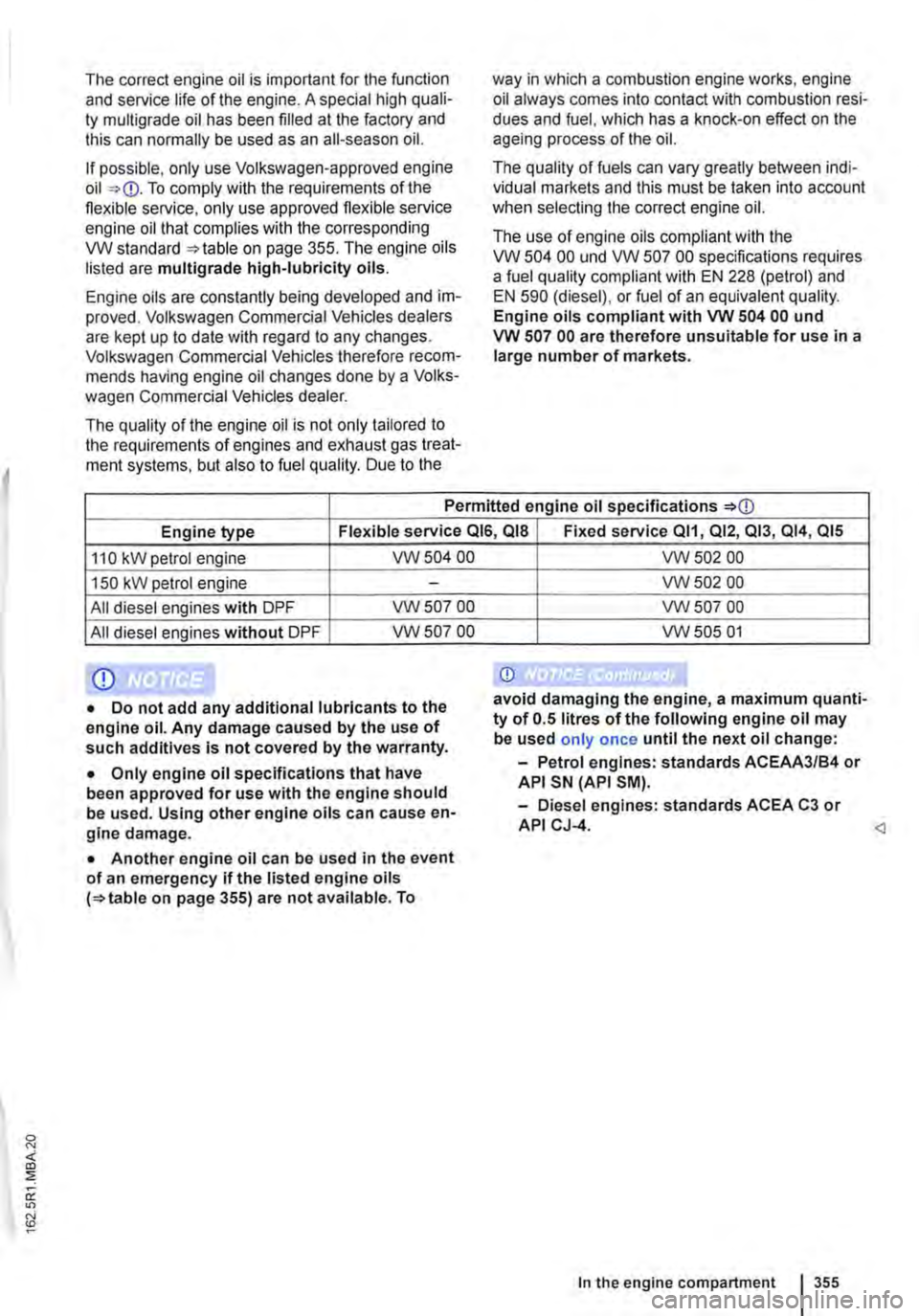
The correct engine oil is important for the function and service life of the engine. A special high quali-ty multigrade oil has been filled at the factory and this can normally be used as an all-season oil.
If possible, only use Volkswagen-approved engine oil =>CD. To comply with the requirements of the flexible service, only use approved flexible service engine oil that complies with the corresponding VW standard =>table on page 355. The engine oils listed are multigrade high-lubricity oils.
Engine oils are constantly being developed and im-proved. Volkswagen Commercial Vehicles dealers are kept up to date with regard to any changes. Volkswagen Commercial Vehicles therefore recom-mends having engine oil changes done by a Volks-wagen Commercial Vehicles dealer.
The quality of the engine oil is not only tailored to the requirements of engines and exhaust gas treat-ment systems, but also to fuel quality. Due to the
way in which a combustion engine works, engine oil always comes into contact with combustion resi-dues and fuel, which has a knock-on effect on the ageing process of the oil.
The quality of fuels can vary greatly between indi-vidual markets and this must be taken into account when selecting the correct engine oil.
The use of engine oils compliant with the VW 504 00 und VW 507 00 specifications requires a fuel quality compliant with EN 228 (petrol) and EN 590 (diesel), or fuel of an equivalent quality. Engine oils compliant with VW 504 00 und VW 507 00 are therefore unsuitable for use in a large number of markets.
Permitted engine oil specifications =>CD
Engine type Flexible service QIS, QIS Fixed service Ql1, Ql2, Q13, Ql4, Ql5
110 kW petrol engine VW504 00
150 kW petrol engine -
All diesel engines with DPF VW507 00
All diesel engines without DPF VW507 00
CD
• Do not add any additional lubricants to the engine oil. Any damage caused by the use of such additives is not covered by the warranty.
• Only engine oil specifications that have been approved for use with the engine should be used. Using other engine oils can cause en-gine damage.
• Another engine oil can be used in the event of an emergency if the listed engine oils (=>table on page 355) are not available. To
vw 502 00
VW502 00
VW507 00
VW505 01
CD
avoid damaging the engine, a maximum quanti-ty of 0.5 litres of the following engine oil may be used only once until the next oil change:
-Petrol engines: standards ACEAA3/B4 or API SN (API SM).
-Diesel engines: standards ACEA C3 or APICJ4.
In the engine compartment 1355
Page 357 of 486
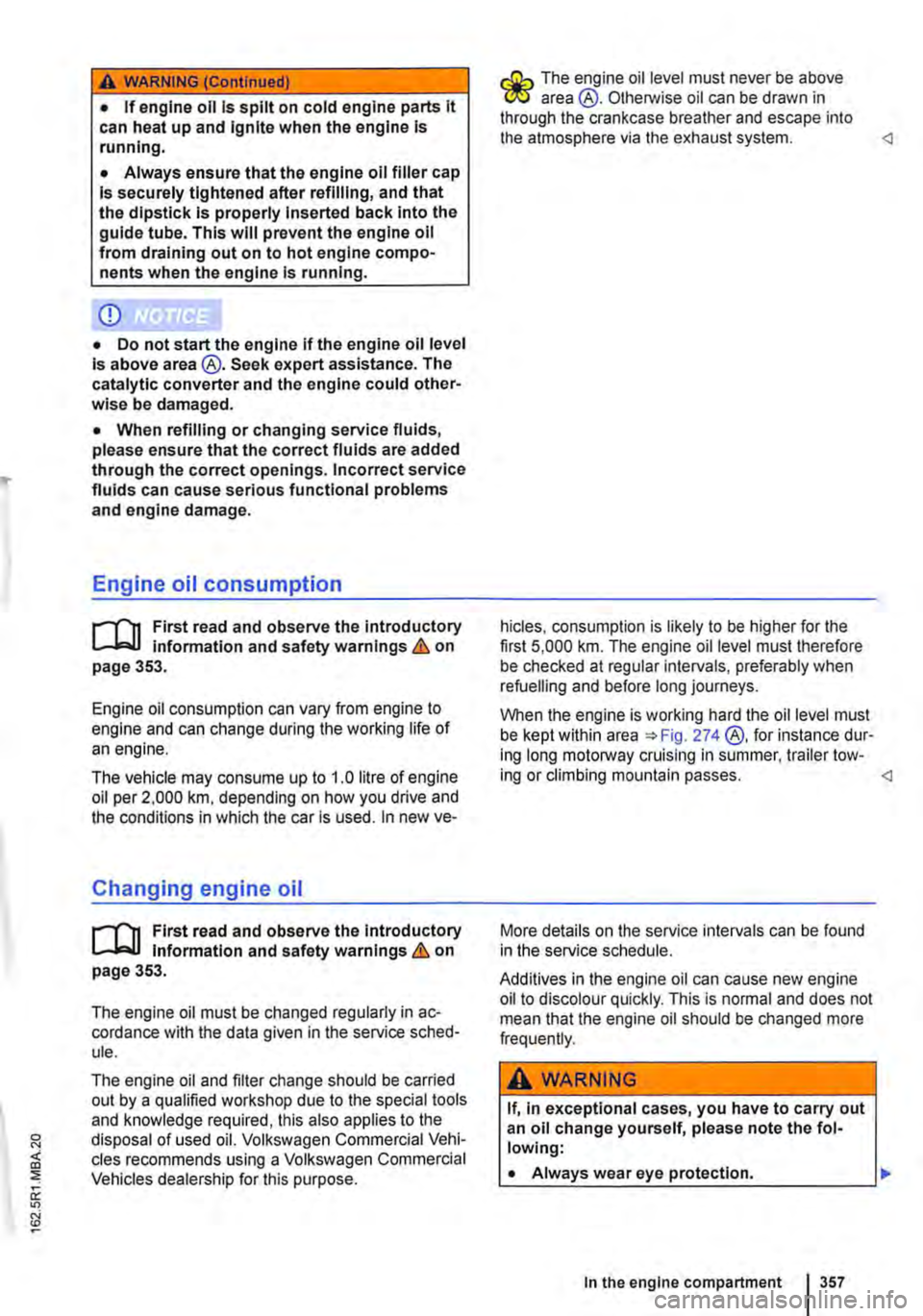
A WARNING (Continued)
• If engine oil is spilt on cold engine parts it can heat up and Ignite when the engine Is running.
• Always ensure that the engine oil filler cap Is securely tightened after refilling, and that the dipstick Is properly Inserted back Into the guide tube. This will prevent the engine oil from draining out on to hot engine compo-nents when the engine Is running.
CD
• Do not start the engine if the engine oil level Is above area@. Seek expert assistance. The catalytic converter and the engine could other-wise be damaged.
• When refilling or changing service fluids, please ensure that the correct fluids are added through the correct openings. Incorrect service fluids can cause serious functional problems and engine damage.
Engine oil consumption
n"'n First read and observe the introductory l.-J,:.ll information and safety warnings & on page 353.
Engine oil consumption can vary from engine to engine and can change during the working life of an engine.
The vehicle may consume up to 1.0 litre of engine oil per 2,000 km, depending on how you drive and the conditions in which the car is used. In new ve-
Changing engine oil
n"'n First read and observe the Introductory l.-J,:.ll Information and safety warnings & on page 353.
The engine oil must be changed regularly in ac-cordance with the data given in the service sched-ule.
The engine oil and filter change should be carried out by a qualified workshop due to the special tools and knowledge required, this also applies to the disposal of used oil. Volkswagen Commercial Vehi-cles recommends using a Volkswagen Commercial Vehicles dealership for this purpose.
The engine oil level must never be above I!!S area @. Otherwise oil can be drawn in through the crankcase breather and escape into the atmosphere via the exhaust system. <1
hicles. consumption is likely to be higher for the first 5,000 km. The engine oil level must therefore be checked at regular intervals, preferably when refuelling and before long journeys.
When the engine is working hard the oil level must be kept within area =>Fig. 274 @,for instance dur-ing long motorway cruising in summer, trailer tow-ing or climbing mountain passes. <1
More details on the service intervals can be found in the service schedule.
Additives in the engine oil can cause new engine oil to discolour quickly. This is normal and does not mean that the engine oil should be changed more frequently.
A WARNING
If, In exceptional cases, you have to carry out an oil change yourself, please note the fol-lowing:
• Always wear eye protection. .,.
In the engine compartment 357
Page 476 of 486
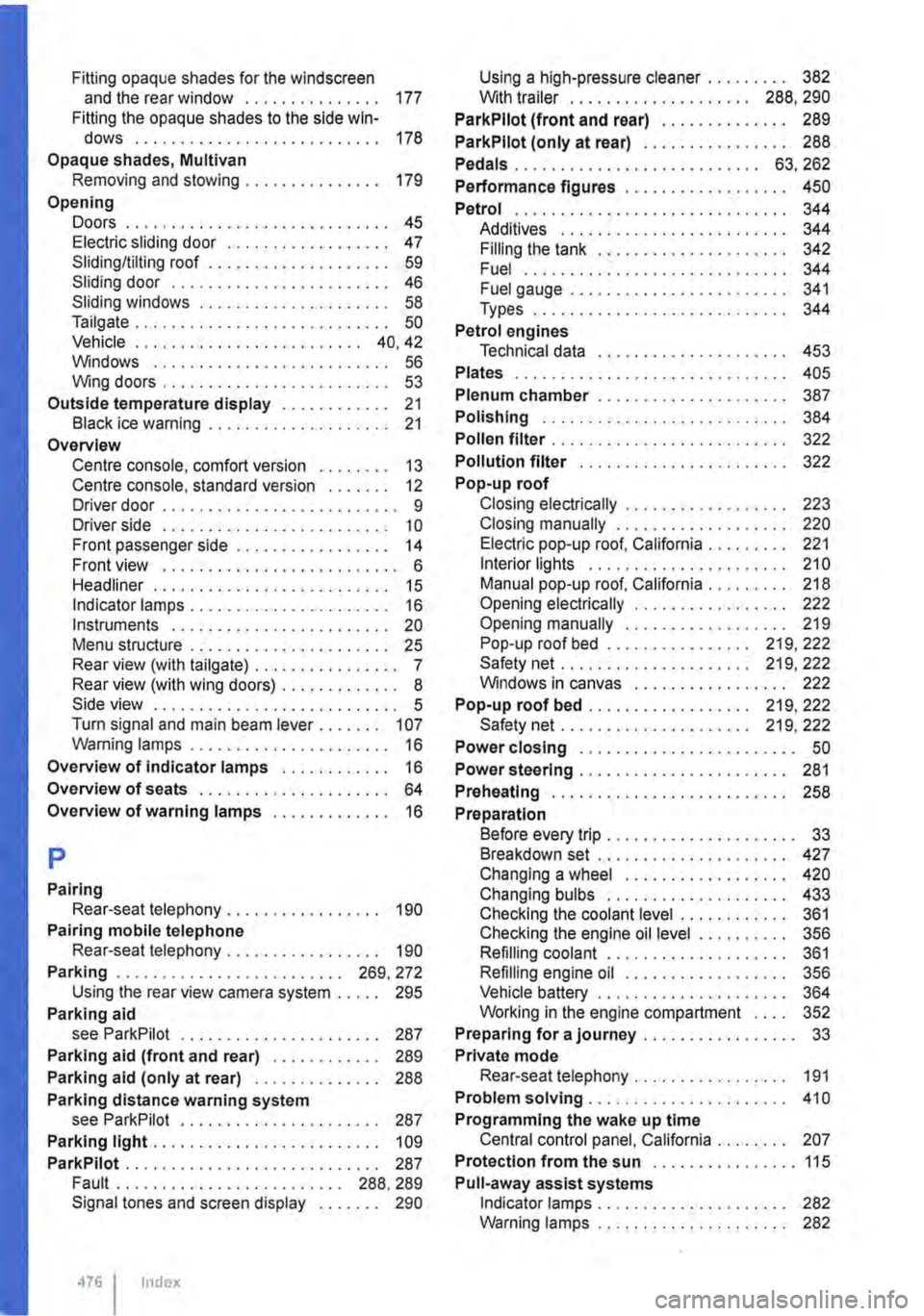
Fitting opaque shades for the windscreen and the rear window . . . . . . . . . . . . . . . 177 Fitting the opaque shades to the side win-dows . . . . . . . . . . . . . . . . . . . . . . . . . . . 178 Opaque shades, Multivan Removing and stowing ........... , . . . 179
Opening Doors . . . . . . . . . . . . . . . . . . . . . • . . . . . . . 45 Electric sliding door . . . . . . . . . . . . . . . . . . 47 Sliding/tilting roof . . . . . . . . . . . . . . . . . . . . 59 Sliding door . . . . . . . . • . . . . . . . . . . . . . . . 46 Sliding windows . . . . . . . . . . . . . . . . . . . . . 58 Tailgate . . . . . . . . . . . . . . . . . . . . . . . . . . . . 50 Vehicle . . . . . . . . . . . . • . . . . . . . . . . . . 40, 42 Windows .......................... 56 Wing doors . . . . . . . . . . . . . . . . . . . . . • . . . 53
Outside temperature display . . . . . . . . . . . . 21 Black ice warning . . . . . . . . . . . . . . . . . . . . 21 Overview Centre console, comfort version . . . . . . . . 13 Centre console, standard version . . . . . . . 12 Driver door . . . . . . . . . . . . . . . . . . . . . . . . . . 9 Driver side . . . . . . . . . . . . . . . . . . . . . . . . . 10 Front passenger side . . . . . . . . . . . .. . • . . 14 Front view . . . . . . . . . . . . . . . . . . . . . . • . . . 6 Headliner .................... , . . • . . 15 Indicator lamps . . . . . . . . . . . . . . . . . . . . . . 16 Instruments . . . . . . . . . . . . . . . . . . . . . . . . 20 Menu structure . . . . . . . . . . . . . . • . . . . . . . 25 Rear view (with tailgate) . . . . . . . . . . . . . . . . 7 Rear view (with wing doors) . . . . . . . • . . . . . 8 Side view ........................... 5 Turn signal and main beam lever . . . . . . . 107 Warning lamps . . . . . . . . . . . . . . . . . • . . . . 16
Overview of indicator lamps . . . . . . . . . . . . 16
Overview of seats . . . . . . . . . . . • . . . . . . . . . 64
Overview of warning lamps ... , . . . . . . . . . 16
p
Pairing Rear-seat telephony... . . . . . . . . . . . . . . 190 Pairing mobile telephone Rear-seat telephony................. 190
Parking . . . . . . . . . . . . . . . . . . . . . . . . . 269, 272 Using the rear view camera system . . . . . 295
Parking aid see ParkPilot . . . . . . . . . . . . . . • . . . . . . . 287
Parking aid (front and rear) . . . . . . . . . . . . 289
Parking aid (only at rear) . . . . . . . . . . . . . . 288
Parking distance warning system see ParkPilot . . . . . . . . . . . . . . . . . . . . . . 287
Parking light..... . . . . . . . . . . • . . . . . . . . . 109
ParkPIIot . . . . . . . . . . . . . . . . . . . . . . . . . . . . 287 Fault . . . . . . . . . . . . . . . . . . . . . . . . . 288. 289 Signal tones and screen display . . . . . . . 290
476 I Index
Using a high-pressure cleaner . . . . . . . . . 382 Wilh trailer . . . . . . . . . . . . . . . . . . . . 288, 290
ParkPilot (front and rear) . . . . . . . . . . . . . . 289
ParkPilot (only at rear) . . . . . . . . . . . . . . . . 288
Pedals . . . . . . . . . . . . . . . . . . . . • . . • . . . 63, 262
Performance figures . . . . . . . . . . . . . . . . . . 450
Petrol . . . . . . . . . . . . . . . . . . • . . . . . . . . . . . 344 Additives . . . . . . . • . . . . . . . . . . . . . . • . . 344 Filling the tank . . . • . . . . . • . . . . . . . . • . . 342 Fuel ..........................•.. 344 Fuel gauge . . . . . . . . . . . . • . . • . . . . . • . . 341 Types . . . . . . . . . . . . . . . . . . . . . . . . . . . . 344
Petrol engines Technical data . . . . • . . . . . . . . . . . . . . . . 453
Plates . . . . . . . . . . . . . . . . . . . . . . . . . . . . . . 405
Plenum chamber . . . . . . . • . . . . . . . . • . . . . 387
Polishing . . . . . . . . . . . . . • . . . . . . . . . . . . . 384
Pollen filter . . . . . . . . . . . . . . . . . . . . . . . . . . 322
Pollution filter . . . . . . . . . . . . • . . • . . . . . . . 322
Pop-up roof Closing electrically . . . . . . . . . . . . . . . . . . 223 Closing manually . . . . . . . . . . . . . . . . . . . 220 Electric pop-up roof, California . . . . . . . . . 221 Interior lights . . . . . . . . . . . . . . . . . . . . . . 210 Manual pop-up roof, California......... 218 Opening electrically . . . . . . . . . . . . . . . . . 222 Opening manually . . . . . . . . . . . . . . . . . . 219 Pop-up roof bed . . . . . . . . . . • . . • . . 219, 222 Safety net..................... 219, 222 Windows in canvas . . . . . . . . . . . . . . . . . 222
Pop-up roof bed . . . . . . . . . . . . . . . . . . 219, 222 Safety net . . . . . . . . . . . . . • . . . . . . . 219, 222
Power closing . . . . . • . . • . . . . . • . . . . . . . . . 50
Power steering . . . . . . . . . . . . . . . . . . . . . . . 281
Preheatlng . . . . . . . . . . . . . . . . . • . . . . . . . . 258
Preparation Before every trip . . . . . . . . . . . . . . . . . . . . . 33 Breakdown set . . . . . . . . . . . . . . . . . . . . . 427 Changing a wheel . . . . . . . . . . . . . • . . . . 420 Changing bulbs . . . . . . . . . . . . . . . • . . . . 433 Checking the coolant level . . . . . . . . . . . . 361 Checking the engine oil level . . . . . . . . . . 356 Refilling coolant . . . . . . . . . . . . . . . . . . . . 361 Refilling engine oil . . . . . . . . . . . . . . . . . . 356 Vehicle battery . . . . . . . . . . . . . . . . . . . . . 364 Working in the engine compartment . . . . 352
Preparing for a journey . . . . . . . . . . . . . . . . . 33 Private mode Rear-seat telephony . . . . . . . . . . . . . . . . . 191
Problem solving...................... 410
Programming the wake up time Central control panel, California . . . . . . . . 207
Protection from the sun . . . . . . . . . . . . . . . . 115
Pull-away assist systems Indicator lamps . . . . . . . . . . . . . . . . . . . . . 282 Warning lamps . . . . . . . . . . . . . . . . . . . . . 282